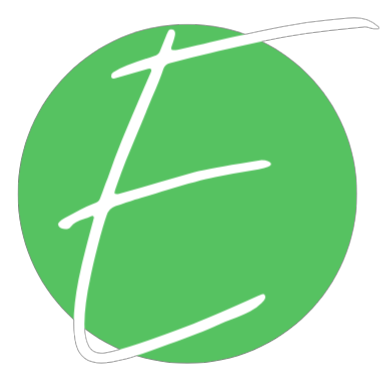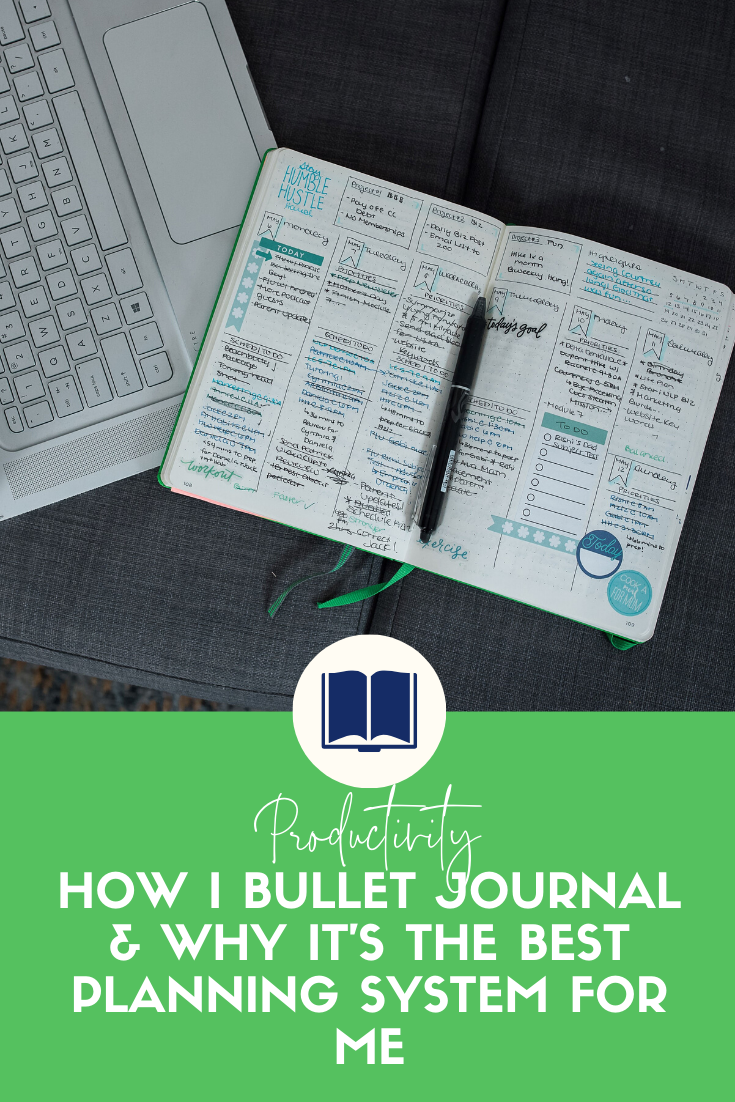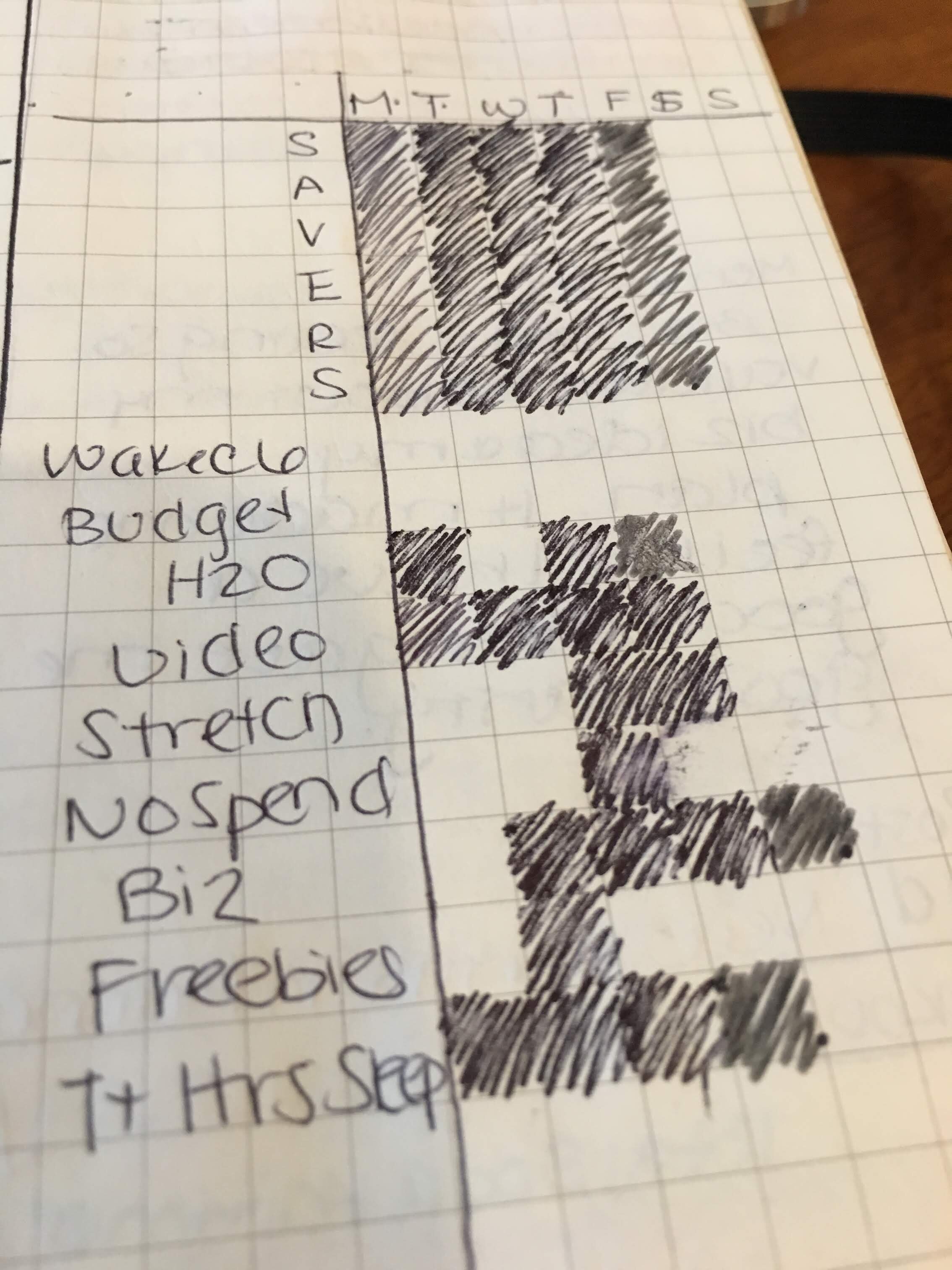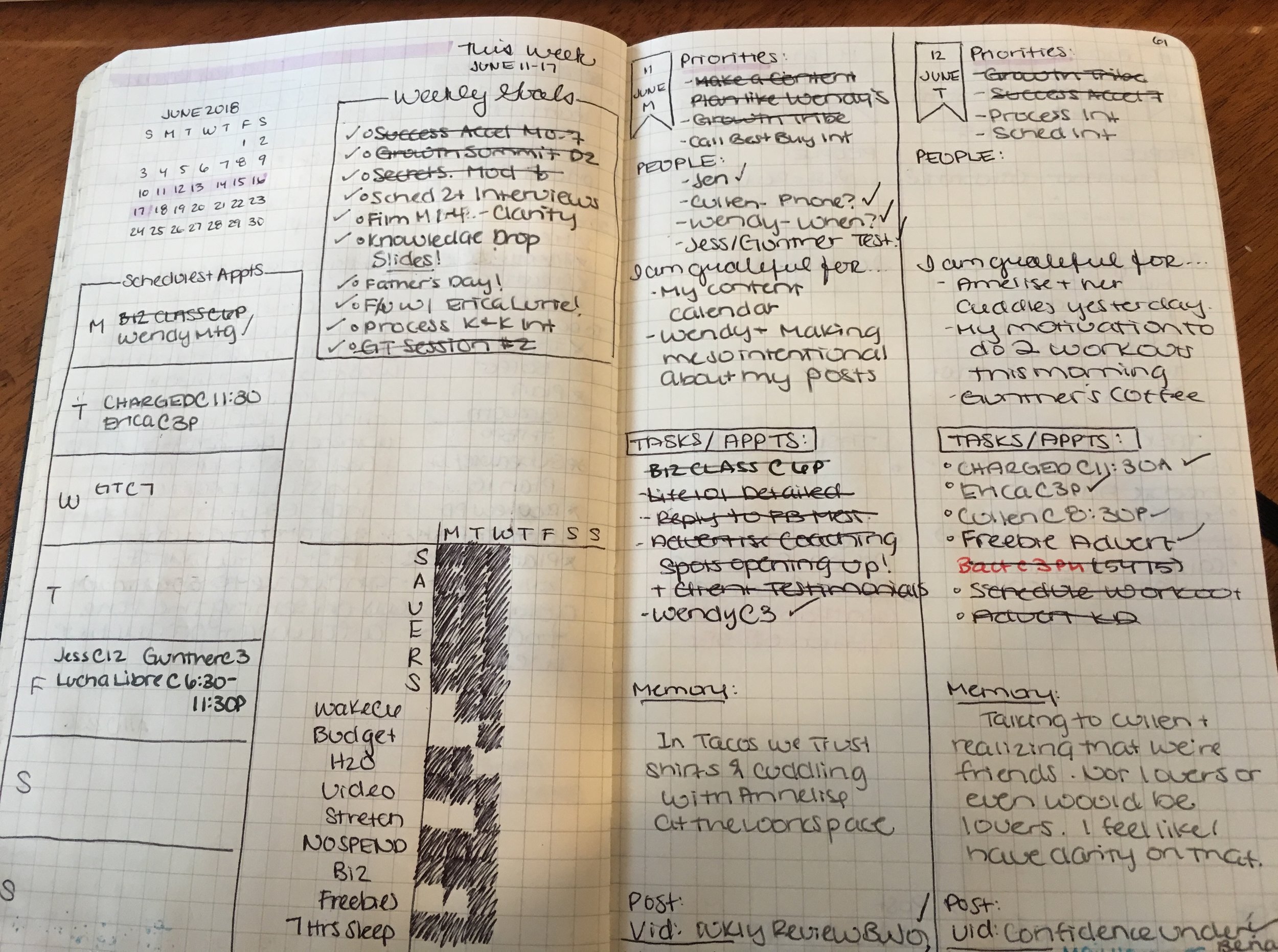How I Bullet Journal & Why It's the Best Planning System for Me
how many planners have you tried?
Well, I've tried a whole hell of a lot,
and I've never quite found one that I loved.
The Plum Paper Planner - It's just not great quality.
The DailyGreatness Journal - It's awesome on the habits. But, tried to do too much and didn't have enough of a planning element for me.
The Erin Condren Life Planner - Great quality and construction, but was missing the healthy habit elements and it wasn't customizable enough for me. I know, I know. That might be blasphemy to #ECLP addicts
The Happy Planner - Probably the closest I've come to absolutely loving a planner. Totally customizable with it's removable pages, but was missing something.
Then, when I was in Medellin, I was at an art store (always a dangerous place for me to be) and I found Moleskine notebooks and I thought to myself, what about a Bullet Journal?
Well, let's just say I'm in love. Ever since I started using it, I've been absolutely in love with the customizability of the system, how easy it is to implement, and how perfect the system is for me. But, as I was starting my journey into Bullet Journal-ing, I realized that there is a lot wrong with the Bullet Journal culture. Namely, it's overwhelming as all hell. I realized that a lot of the "Bullet Journaling for Beginners" stuff you find on Pinterest are complete and utter BS. I mean, they're incredibly artsy, photogenic layout and they're beautiful! But are they practical? I'm sorry, but if I'm a) just getting started and b) wanting a simple solution that going to get me organized so that I have MORE time? I don't want to do that!
What I've realized since starting my Bullet Journal is that it doesn't have to be complicated. You can create an EFFECTIVE planning system AND you can do in a SIMPLE way that still looks incredibly beautiful and aesthetic (if you're into that!). In my newest blog post, I've walked you through how I use my Bullet Journal, what's important in your layouts and some SIMPLE places to start! Link in Bio!
Before we start...
I want to tell you what I like best about the Bullet Journal system
It's customizable. My biggest hang up with so many other planning systems is that I felt like I couldn't adapt it to me. If it was a strict planner, I wanted it to have more lifestyle, health, habit features for me to use. If it was more habit + lifestyle adapted, it didn't have enough planning elements. This system allows me to customize my Bullet Journal for exactly what I want to use it for and for how I want to use it. That customizability is invaluable in my opinion.
It's easy to implement. You really don't need anything to start using a Bullet Journal. Ya, there are definitely materials that I recommend, which I've detailed below, but the bottom line is you need a notebook and a pen. That's it. You don't need to order off of some online store and wait multiple weeks for your planner to arrive. You don't have to go to a special store to buy the planner. You can go anywhere that sells notebooks and pens, really, and you're ready to get started.
It allows me to be creative. I've found that I love that creative outlet with my planners. With the Erin Condren and Happy Planners, particularly the Happy Planner, I loved all the stickers and the ways that I could decorate the planner. It was fun for this former-scrapbook fiend to engage in that creativity. I was afraid a Bullet Journal wouldn't give me that. But, what I love is that the whole process of drawing out your layout is an exercise in creativity and finding simple, easy ways to add in pops of color or creative elements allows me to play and be creative in a way that isn't overwhelming or that makes my Bullet Journal to labor-intensive.
It's cheaper. Unless you're one of those people that goes crazy with the water colored pens, Washi tape, etc., Bullet journaling is so so cheap compared to other planning systems. Erin Condren planners run for $50 a pop. Happy Planners are cheaper, but still can be steep. And then you've got all the add-ons and stickers and customization, etc. Basically, it can add up and it can add up FAST. With the Bullet Journal, at least with the approach I take, all you need is a notebook and some pens and that is SO much cheaper.
here are my SUGGESTED MATERIALS:
A gridded or dot grid notebook. I use this Moleskine gridded notebook, but I also really like Leuchtturm Notebooks like this dotted version. The nice thing about the Leuchtturm notebooks is that they are pre-numbered, but they're also a little bit more expensive! But it's important that your notebook has a grid or is dotted. Lined is okay, but I think the grid is more useful for some of the different things that you can do with the bullet journal.
Pilot Frixion Erasable Pens. I'm obsessed with these pens and I've been getting friends obsessed with them for months because they're the only erasable pen I've ever used that is actually 100% erasable! I love them! Here are some in multiple colors and here are multiple black pens. Plus, they're retractable! These are my favorite pens!
Other than that, I like to have some highlighters for some pops of color. I like these Sharpie highlighter pens. This is how I get a little bit of color and extra design elements into my planner without resorting to all the washi tape, watercolor pens, etc. that a lot of the other really crafty Bullet Journalers use. I like to keep it super simple.
Now that we've got our materials, how do we get started?
First step - Number your pages. Step 1 with any journaling system is to label your pages. Again, if you have the Leuchtturm notebook, your pages will already be numbered, but if you're using a Moleskine or another type of notebook, you will have to number the pages. This is a really important first step because you will want and need to use the page numbers to keep track of where things are located in your Bullet Journal, especially if you choose to include collections in your notebook (we'll talk about what those are later). But start by numbering your pages.
Then, create your Table of Contents. After you've number your pages, reserve a couple pages at the beginning of your Bullet Journal for your Table of Contents. This is an important section and where your page numbering will come in handy. I use mine to keep track of some of my collections and my calendars. The more collections you add to your Bullet Journal, meaning the non-planner elements of your Bullet Journal, the more important that this section will be because it will be important for your ability to keep track of where these different things are located. Check out these entries on Pinterest for some inspiration on how to create a simple Bullet Journal Table of Contents.
After my Table of Contents, I have my goals. Why do I include this as my next step? Because, in my opinion, before you get to planning, you need to know what you're planning for. So, it's important to game plan your goals before you move onto the actual planning section of your Bullet Journal planner. For me, the pages right after my Table of Contents are dedicated to my over-arching goals for the entire year of 2018. Then, I usually breakdown my goals into monthly goals. So, I made a layout for each month and what I'm going to focus on and get down by that month. So, this is something that I forgot to include after my yearly goals. Instead, I included this at the back of my planner instead. What this looks like is, If I wanted to complete 4 workout programs over the course of year, what programs am I going to do and when do I approximately need to complete them by? Basically, that means I need to complete at least one workout program each quarter. So, that becomes my monthly/quarterly goal. If I want to complete 50 interviews for my grad school book over the course of the year, what does that look like? That means I need to complete 4-5 interviews each month and I write that into my monthly goals as well. It's important to think about this at the start of your Bullet Journaling so that when you get to your Monthly and Weekly spreads, you already know what goals need to be completed during each month/week.
After that, I start planning.
Monthly spreads. My planning start with my Monthly spread. This is a one page spread that can be seen to the right on the left side of the top image. Basically, I use my monthly spread as a broad overview of the Month. I use the date list on the right of the page to keep track of an important things that are coming up! Birthdays. Deadlines. Events. All of those go in the date list. Then, next to that, I right all of my goals for the month. Part of these goals are my goals that we discussed above. What workout program am I going to start/finish? What personal growth programs do I want to finish? What progress do I want to make on my book? All of these goals go in my Monthly goals, along with my income goals, my business growth goals, etc. I write these into my Monthly goals so that I can refer back to this as I game plan my weekly goals.
Weekly spreads. In my weekly spreads, I again take a broad overview of the week and the appointments, events and commitments that are coming up, but more importantly than that broad overview, I also have my Weekly goals and my Habit tracker on my weekly spread. My weekly goals are benchmarked and broken-down versions of my Monthly goals. If I want to complete 10 interviews in the month, then my weekly goal is to complete 2-3 interviews in the week. If I want to complete an 8-module personal growth training that month, my weekly goal will be to complete 2 modules that week. I break my monthly goals down to what needs to happen each week to complete that goal over the course of the month and write those goals into my Weekly spread. My Habit Tracker is also an essential part of my weekly spread. It's includes the daily habits or weekly habits that I need to complete. This includes my Miracle Morning activities, which are denotes with the acronym SAVERS in the Habit tracker, waking up at 6, budgeting at least 1x a week, drinking 75+ oz of water each day, etc. Each time I complete an activity, I track it in my Habit tracker.
Daily spreads. My daily spreads are a practical version of Brendon Burchard's 1 Pg Productivity Planner. The important parts of this daily spread, which are currently set up in columns in my Bullet Journal, though I'll be experimenting with different layouts over the next couple months! The important aspects of my daily layout are firstly setting my priorities for each day. I try to limit myself to 3-5 priorities, which are the must-do items that have to get done that day. The next section is my "People" section, asking the question of who I'm waiting on and who I need to reach out to that day. When I get to the point where I start checking my emails or making contact with people, these are the first people I reach out to first and foremost before I get distracted by other emails or social media messages. Then, it's my tasks for the day. Oftentimes, these are related to appointments and client meetings that I have or edits that I need to get done for my science editing part-time gig. Additional activities that I have time for during the day will also get written into this "tasks" sections. I've also added in a "Memory" section where I challenge myself to come up with a good memory for the day. Sometimes this is really really easy, but othertimes, when I've had a bad day this is a lot harder. Last, but not least, I have a section at the bottom of my planner where I keep track of Biz activities and health-related habits. REgarding my biz activities, I plan my social media posts and the LIVE videos I do in my Facebook communities in this section by writing in the topic of my video for the day. For my health habits, I write what workout I'm doing that day and I also have a water tracker at the bottom of the page. And that's my daily spread. It's just a single column for the day, two days per page.
Collections - What collections do I like to use?
"Collections" refers to anything that you include in your bullet journal that really doesn't relate to it being a planner. It's anything you keep track of outside of your calendar within the context of the bullet journal. I use a number of different collections in my Bullet journal, but I would like to note that these collections are, for the most part, things that I added after the fact. I didn't start by trying to add all these collections. I just started with the planner aspects of the Bullet Journal. So if you're new to the Bullet Journal, I would wait to add these into your Bullet Journal until later.
My Career Vision Timeline - Aka the #GirlBoss Timeline. I don't know what inspired this necessarily, but one of the things that I love that I included in my Bullet Journal is basically what I call my #GirlBoss Timeline. Basically, I treated this as a 10-15 year look at all the things I want to accomplish in my career. When do I want to publish books? When do I want to go to certain, high-profile seminars? When do I want to hit certain milestones in my income and my following? All of these are included in my #GirlBoss Timeline, including the phrase, "Top Female Speaker/Coach in the World."
Level 10 Life & Plan. I love the Level 10 Life. I don't remember who originally coined that concept, but I've heard and used so many derivatives of this goal-setting and visualization framework. I really enjoyed implementing this to see where I was at the beginning of the year and to really visualize where I wanted to take things in my life over the next few years! And it's just nice to have that reminder of what the big goals are in a really simple format that I can reference whenever I've lacking motivation or enthusiasm.
Health Stats + Workout Schedule/Plan. I made a commitment at the beginning of this year to get in the best shape of my life by the end of the year and so far I'm really happy with the progress I've made! One of the ways that I'm tracking that progress is with a page in my Bullet Journal where I'm simply tracking my measurements. I don't weigh myself, but I wanted a way to measure my progress that was tangible. So I brought a tape measure to measure myself. I also find using how my clothes are fitting to be useful as well. In addition to the page where I track my health stats, I also have a page in my planner where I track my Workout Schedule and plan. What I mean by this is I have game planned out what workout programs I'm going to be doing, when I plan on starting and finishing them, when I'm going to take a week of rest and recovery between workout programs and what workout program i'm going to plan on doing next. I also have taken into consideration where I'm going to be doing Half Marathon training in this. This is a nice reference to make sure that I have a game plan for the whole year.
Books to Read. As you probably know, personal growth is huge for me. And to make sure I'm consistent with my personal growth practice, I've been reading about a book a week, with the goal of reading 50 books this year. As a way to track this, I have a page in my Bullet Journal where I simply write down the name of the book I'm reading and I put a check next to it when the book has been completed. This is one of the simpler pages in my Bullet Journal and simply serves as a tracker of what and how many books I've read throughout the year.
Business Plan - Ex. Program Launch Map. I'm planning a big program launch for this Fall and with that, there have been a lot of logistical pieces involved in getting the program ready. These have included creating and filming the content for the programs, game-planning social media and audience growth, creating logistical plans for the launch and some of the launch details, including budgeting, revenue targets, etc. Basically, there's a lot of stuff to keep track of and remember to do. So, I dedicated a few pages in the back of my Bullet Journal to keep track of some of these logistical pieces of the launch that I can check off once I complete them. It's nice to have it with my planner because I can very easily reference this spread as I'm writing my monthly and weekly goals!
Business Plan - Content Planner. Similarly, I also have a content planner for my Business in my Bullet Journal. This isn't the detailed "What I'm going to post on Instagram & When" plan. Instead, it's just a generally outline for the types of content that I'm going to share each day and each week to help guide me as I write and plan content for the week and month. This is especially helpful when I'm running short on ideas and creativity. I also use this to set goals and plans around how frequently and on what schedule I want to post on my blo, share my Newsletter, and when I want to start a Podcast, which is something that has recently been added to my goals.
Meal Plan Ideas + Examples. Last, but not least, one of my favorite Collections and spreads is my Meal Plan. It's not necessarily a meal plan in the traditional sense. Ever since I did 80 Day Obsession in January-March, I have been eating on a timed nutrition plan and have been eating very very similar meals from day-to-day. I use my meal plan ideas and examples to give myself examples of meals, snacks, etc. that fit into this timed nutrition, 80 Day Obsession meal plan. This is great when I'm writing my grocery lists and making plans for the next week's meals because I don't have to reference the 80 Day Obsession meal guide. I just glance at this spread and I know what fits into that style of eating! :-)
Lastly, Check out My Walk-Through Video for...
my No-BS, Simple, Efficient Bullet Journal Tips for Beginners!
Update June 2020
I wanted to update you all on my current journaling and planning systems. Things have changed a lot over the years and though I loved aspects of the bullet journal system, the effort it took to create a bullet journal every single time was too much.
I pivoted to a bullet journal for a while, but ultimately I found that creating my own planner - the Take Back Your Time planner - was the best option for me. After trial and error and using a ton of different planning systems over the years, I’ve found that though I love the intentional and mindfulness aspects of the daily greatness journal, I need more review and goal setting in my planner. I needed something that was going to allow me to evaluate myself day-in and day-out, incorporating all my systems for intuitive achievement and goals, but without the need to re-draw and create my bullet journal layouts each month and each year. That’s why I created the Take Back Your Time planner.
TheTake Back Your Time planneris designed to help you cultivate more self-awareness and to achieve your goals using what I call “intuitive achievement” to help you create a life you f’ing love on your terms! It’s taken all of the things I learned and loved from the Daily Greatness journal, my bullet journaling, etc. and I highly encourage you to check it out!





